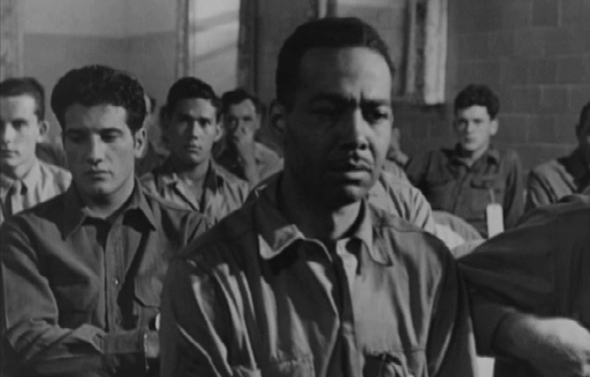Yesterday, the National Film Preservation Foundation began streaming a rare and controversial documentary director John Huston made when he was a major in the Army's Signal Corps during World War II. Let There Be Light (1946), eventually preserved by the National Archives and transferred from a 35mm negative, was a monumental production for a 58-minute documentary. Huston's A-list team, lead by The Magnificent Amberson's cinematographer Stanley Cortez, shot 375,000 feet of film or some 70 hours to make sure they captured "the extraordinary and completely unpredictable exchanges that sometimes occurred" among the subjects. A poor print of the film was shown to the public in 1980 but, because of its unflinching look at war-induced psychological trauma, the Army mostly kept it shelved from view.
Huston directed and wrote Let There Be Light and his father, the actor Walter Huston, narrates. Had it been released when it was finished in 1946, it would have revealed several firsts to the viewing public, notably the way in which Huston investigates the taboo subject of what we now know as post-traumatic stress disorder. Despite the scripted narration, he lets the cameras roll during unscripted interviews with the veterans at Mason General Hospital in Long Island and produces one of the clearest examples of cinema vérité a good ten years before it became a recognizable style. The original idea, Huston said at the time, was to give these returning soldiers a better chance by removing the stigma of damage and show them interacting normally on camera. The plan was "to show the film to those who would be able to give employment in industry, to reassure them that the men discharged under this section were not insane, but were employable, as trustworthy as anyone." Unfortunately, that didn't happen.
What also makes Let There Be Light unique is the way it honestly portrays an integrated veteran force that was still officially segretated in battle. And though it did leave the more violent treatments like electroshock therapy on the cutting room floor, the film was too much for officials in the end. Huston initially got the greenlight from the War Department, after arriving in Washington with a print of the film to personally screen for authories. But a lobbying group soon convinced the department to restrict its release to only a few Army hospitals here and abroad. Huston was told the film "violated the privacy of the patients involved" and there was no convincing the War Department otherwise. "The men who were in the picture—the patients whose recoveries we had witnessed—were proud of what they saw of themselves on the screen," he said. "Though this is a deeply personal investigation into the innermost lives of these men, nothing was disclosed which might cause them to be ashamed. As a matter of form, we had asked them to sign releases, and they were happy to do so. [But] the authorities had made up their minds."
You can watch the documentary in its entirety on the NFPF's site here. You can also download the MPEG file to watch it on your own player.
That wasn't the only Huston documentary the Army had trouble with. The Battle of San Pietro, which Huston directed while embedded with the Army’s 143rd regiment of the 36th division in Europe, was shot during a victorious yet costly battle against a German stronghold in Italy that claimed some 1,100 U.S. soldiers' lives and destroyed the town of San Pietro Infine in the process. Huston's cameramen climbed the rocky hills with the soldiers into battle but also recorded the casualties in stark detail, something not done in the newsreels or films of the time. The Army's top brass eventually championed the documentary and it was restored and preserved by the National Film Registry in 1991. You can watch it here (it's our Video of the Day.)
Sections: Video
Topics: Blog Films and Filmmakers Short Film (documentary) John Huston Let There Be Light WWII documentary
Did you enjoy this article? Sign up to receive the StudioDaily Fix eletter containing the latest stories, including news, videos, interviews, reviews and more.


Leave a Reply